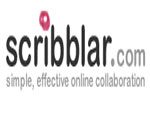At a Glance
What is it?
Website
Scribblar

Scribblar is designed to be an online collaborative effort that empowers users to develop and maintain a scholarly conversation at any time. Several tools are optimal for the use of the online whiteboard, while the audio and text messaging features facilitate collaboration among users. This is an ideal tool for groups of students and teachers to brainstorm and plan outside of class hours, but with some forethought Scribblar also has the potential of being used as a virtual classroom.
Getting Started
The first step, once activation is complete, is to create a room and set privacy stipulations (an important consideration for school policies). After setting up the room, users arrive at a blank canvas—a plain whiteboard. The menu items on the right include a pointer/selector, various geometric shapes, and writing tools: drawing, text, highlighting, and stamping. Also to the right is a microphone button to start an audio conference and a space below for text messaging with other group members. Horizontal buttons along the top include the usual word processing and photo editing features: cut, copy, paste, undo, redo, delete, flip horizontally and vertically; additional tools include lock, unlock, clear page (and all pages), take snapshot, equation editor, shared pointer, page background (with numeric color value), and page draw mode. At the bottom of the screen, users can select line color, fill color, and line thickness. To write on the whiteboard, users can either use the text button or the pencil button for freestyle writing. Shapes can be brought to the front for layering purposes, by right-clicking the object (text or shape).
In many ways, Scribblar merges the skills of word processing with the purpose of whiteboard instruction and planning. Users can also build graphic organizers easily and the "alpha/wolfram" button, in Beta mode, has potential for future social studies table elements. One limitation, however, is that all operating features are controlled through a mouse or trackpad, not with the keyboard. In addition, an "arrow" button is missing and currently users would use a pencil button. Another limitation fails to make the best use of the Web's potential: hyperlinks, interactivity, and multitasking tools/features—which classroom tools such as SmartBoard put to good use—are underdeveloped in Scribblar. Flip horizontal button does not seem to work well, and some objects can't be flipped vertically or horizontally. Lastly, text font options only number between 9‐12 fonts (serf and non-serif) with bold, italics, and underline buttons, while the stamp tool is limited to six options. The current version of Scribblar is perhaps of better "curriculum" use in a math classroom than a history classroom. Still, the ability to import images, such as maps and graphs, help Scribblar serve effectively in a social studies classroom if careful planning takes place first. For example, in the right section (where the list of participants is listed), under the assets tab users can click on the "+" to add a feature or image (file types: PowerPoint, .pdf, .jpeg, .gif, .png—maximum file size is five MB.) Users can also download a file and decide whether to add the item to the whiteboard after upload is complete (only the first five pages of a PowerPoint or .pdf file will be converted in addition to pictures, maps, and other visuals . . . but not audio or video files). Other features in the assets tab include adding a webpage snapshot (it takes about a minute to appear in the "Assets" panel; it is worth noting, however, that adding a webpage snapshot as a background may produce a repetitive image that can be fixed by resizing the target window and then re-taking a snapshot). A great feature is the ability to add a Flickr image because you can search online and immediately paste to whiteboard as an item; also useful are the abilities to create a numeric list for ranking, to use the snapshot button in order to preview the whiteboard in an html window, and to print the whiteboard by right-clicking canvas and selecting the print option. In all, Scribblar offers great potential for online collaboration, planning, and teaching. Classrooms separated by distance would benefit greatly, as well as inter-disciplinary collaboration within a school. Most importantly, Scribblar extends learning outside of classroom hours and is thus well positioned to provide teachers and students flexibility and an online pace for increased engagement in the history curriculum.
Examples
Video tutorials on the Scribblar site provide interested users with some examples of how Scribblar can be used for collaborative planning and teaching.